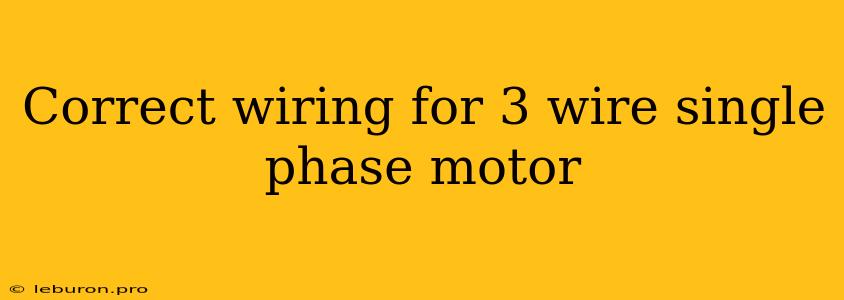Properly wiring a three-wire single-phase motor is crucial for its safe and efficient operation. A three-wire single-phase motor utilizes a single phase power supply and has three wires: two for the main winding and one for the auxiliary winding. The auxiliary winding helps start the motor and provides torque, while the main winding provides the majority of the running power. Incorrect wiring can lead to motor failure, overheating, and even electrical hazards. This article will guide you through the steps of correct wiring for a 3-wire single-phase motor, emphasizing safety precautions and troubleshooting tips.
Understanding the Motor Components
Before you begin, it's essential to understand the different components of a 3-wire single-phase motor:
- Main Winding: The primary winding responsible for the motor's running power.
- Auxiliary Winding: A smaller winding that assists in starting and provides torque.
- Capacitor: A component connected to the auxiliary winding that improves the starting torque and efficiency.
- Terminal Box: A compartment housing the motor's terminals for connection to the power supply.
Types of 3-Wire Single-Phase Motors
There are two primary types of 3-wire single-phase motors:
- Split-Phase Motors: These motors rely on the phase difference between the main and auxiliary windings for starting. They typically have a higher starting torque than capacitor-start motors.
- Capacitor-Start Motors: These motors use a capacitor in series with the auxiliary winding to create a higher starting torque. The capacitor is often switched out of the circuit once the motor reaches a certain speed.
Wiring Diagram for a 3-Wire Single-Phase Motor
The following steps illustrate how to wire a 3-wire single-phase motor using a typical wiring diagram:
-
Identify the Motor Terminals: Locate the terminal box on the motor. Inside, you will find three terminals marked with letters or numbers. Typically, one terminal is labeled 'L' (line), 'T1' (main winding), 'T2' (auxiliary winding), or a combination of these.
-
Identify the Power Supply Wires: The power supply will typically have two wires: a hot wire (black or red) and a neutral wire (white).
-
Connect the Power Supply:
- Hot Wire: Connect the hot wire to the 'L' terminal on the motor.
- Neutral Wire: Connect the neutral wire to the 'N' or '0' terminal on the motor, if available.
-
Connect the Main Winding: Connect one wire from the main winding (T1) to the hot wire (L) on the motor.
-
Connect the Auxiliary Winding: There are two possible scenarios depending on your motor type:
- Split-Phase Motor: Connect the other wire from the main winding (T2) directly to the hot wire (L) on the motor.
- Capacitor-Start Motor: Connect the other wire from the auxiliary winding (T2) to the capacitor. Connect the other side of the capacitor to the hot wire (L) on the motor.
Safety Precautions and Troubleshooting Tips
Always prioritize safety when working with electricity. Follow these precautions before working with a 3-wire single-phase motor:
- Disconnect Power: Always disconnect the power supply before working on the motor.
- Use Proper Tools: Use insulated tools and work on a dry surface.
- Know the Voltage: Ensure that the motor's voltage rating matches the power supply voltage.
- Inspect Wiring: Check for damaged wires, loose connections, or corrosion.
Troubleshooting: If your 3-wire single-phase motor is not working correctly, consider the following:
- Check Connections: Ensure all connections are tight and secure.
- Test the Capacitor: Replace the capacitor if it is faulty.
- Inspect the Motor Winding: Check for damaged or burned windings.
- Check the Power Supply: Ensure the power supply is working properly.
Conclusion
By understanding the components and wiring configurations of a 3-wire single-phase motor, you can ensure its safe and efficient operation. Following the guidelines outlined in this article and prioritizing safety will minimize the risk of electrical hazards and motor malfunctions. Remember to always consult the motor's instruction manual for specific wiring instructions and safety recommendations. Regular maintenance and troubleshooting can help extend the lifespan of your 3-wire single-phase motor and ensure its continued performance.
